Equine keratomycosis due to Aspergillus flavus in Argentina
DOI:
https://doi.org/10.24215/15142590e081Keywords:
Aspergillus flavus complex, natamycin, equine, keratomycosisAbstract
A 9-year-old gelding presented a corneal ulcer unresponsive to treatment in his right eye. The trauma was caused by vegetal material. The ophthalmologic exam revealed paraxial corneal opacity, whitish discharge, peripheral oedema, congestion of conjunctival vessels and corneal angiogenesis. Microscopic examination of smears revealed the presence of neutrophils and fungal hyphae. On day 3 of culture, several small white fluffy colonies that rapidly turned to pale green were detected. These colonies were isolated to study their micro and macromorphology. Microscopic examination revealed the presence of colourless, thick-walled, roughened conidiophores, ranging from 340 to 1650 μm in length, with globose to sub-globose vesicles, ranging from 22 to 48 μm in diameter. Vesicles had one or two series of phialides. Conidia were globose, olive-green with slightly rough, thin walls that ranged from 3 to 7 μm in diameter. Molecular identification was also performed. Both techniques confirmed the presence of Aspergillus flavus complex. Topical treatment with natamycin resulted in healing within 10 days. To our knowledge, this is the first case of equine keratomycosis reported in Argentina.
References
Brooks DE, Plummer CE, Mangan BG, Ben-Shlomo G. 2013. Equine subepithelial keratomycosis. Veterinary Ophthalmology. 16(2):93-6. https://doi.org/10.1111/j.1463-5224.2012.01031.x
Das S, D’Souza S, Gorimanipalli B, Shetty R, Ghosh A, Deshpande V. 2022. Ocular surface infection mediated molecular stress responses. International Journal of Molecular Science. 23(6):3111. https://doi.org/10.3390/ijms23063111
Ferrer C, Colom F, Frasés S, Mulet E, Abad J, Alió JL. 2001. Detection and identification of fungal pathogens by PCR and by ITS2 and 5.8S ribosomal DNA typing in ocular infections. Journal of Clinical Microbiology. 39(8):2873-9. https://doi.org/10.1128/JCM.39.8.2873-2879.2001
Hellander-Edman A, Makdoumi K, Mortensen J, Ekesten B. 2013. Corneal cross-linking in 9 horses with ulcerative keratitis.BMC Veterinary Research. 9:128. https://doi.org/10.1186/1746-6148-9-128
Ledbetter EC. 2017. Antifungal therapy in equine ocular mycotic infections. The Veterinary Clinics of North America Equine Practice 33(3):583-605. https://doi.org/10.1016/j.cveq.2017.08.001
Mustikka M, Grönthal TSM, Pietilä EM. 2020. Equine infectious keratitis in Finland: Associated microbial isolates and susceptibility profiles. Veterinary Ophthalmology. 23(1):148-59. https://doi.org/10.1111/vop.12701
Pearce JW, Giuliano EA, Moore CP. 2009. In vitro susceptibility patterns of Aspergillus and Fusarium species isolated from equine ulcerative keratomycosis cases in the midwestern and Southern United States with inclusion of the new antifungal agent voriconazole. Veterinary Ophthalmology. 12(5):318-24. https://doi.org/10.1111/j.1463-5224.2009.00721.x
Plummer CE. 2017. Corneal response to injury and infection in the horse. Veterinary Clinics of North America Equine Practice. 33(3):439-63. https://doi.org/10.1016/j.cveq.2017.07.002
Richter M, Hauser B, Kaps S, Spiess BM. 2003. Keratitis due to Histoplasma spp. in a horse. Veterinary Ophthalmology. 6(2):99-103. https://doi.org/10.1046/j.1463-5224.2003.00286.x
Roberts D, Cotter HVT, Cubeta M, Gilger BC. 2020. In vitro susceptibility of Aspergillus and Fusarium associated with equine keratitis to new antifungal drugs. Veterinary Ophthalmology. 23(5):918-22. https://doi.org/10.1111/vop.12774
Sherman AB, Clode AB, Gilger BC. 2017. Impact of fungal species cultured on outcome in horses with fungal keratitis. Veterinary Ophthalmology. 20(2):140-6. https://doi.org/10.1111/vop.12381
Tahoun A, Elnafarawy HK, Elmahallawy EK, Abdelhady, A, Rizk AM, El-Sharkawy H, Youssef MA, El-Khodery S, Ibrahim HMM. 2020. Epidemiological and molecular investigation of ocular fungal infection in equine from Egypt. Veterinary Science. 7(3):130. https://doi.org/10.3390/vetsci7030130
Voelter-Ratson K, Monod M, Braun U, Spiess BM. 2013. Ulcerative fungal keratitis in a Brown Swiss cow. Veterinary Ophthalmology. 16(6):464-6. https://doi.org/10.1111/vop.12037
Walther G, Zimmermann A, Theuersbacher J, Kaerger K, von Lilienfeld-Toal M, Roth M, Kampik D, Geerling G, Kurzai O. 2021. Eye infections caused by filamentous fungi: Spectrum and antifungal susceptibility of the prevailing agents in Germany. Journal of Fungi. 7(7):511. https://doi.org/10.3390/jof7070511
Zak A, Siwinska N, Slowikowska M, Borowicz H, Ploneczka–Janeczko K, Chorbinski P, Niedzwiedz, A. 2018. Conjunctival aerobic bacterial flora in healthy Silesian foals and adult horses in Poland. BMC Veterinary Research. 14(1):261. https://doi.org/10.1186/s12917-018-1598-6
Downloads
Published
Issue
Section
License
Copyright (c) 2024 Gustavo Leonardo Zapata, Horacio Terziotti, Marco Tizzano, Romina Della Vedova, Francisco José Reynaldi

This work is licensed under a Creative Commons Attribution-NonCommercial-NoDerivatives 4.0 International License.
Authors retain the copyright and assign to the journal the right of the first publication, with the with the terms of the Creative Commons attribution license. This type of license allows other people to download the work and share it, as long as credit is granted for the authorship, but does not allow them to be changed in any way or used them commercially.

Analecta Veterinaria by School of Veterinary Sciences, National University of La Plata is distributed under a Creative Commons Attribution-NonCommercial-NoDeriv 4.0 International License.


























